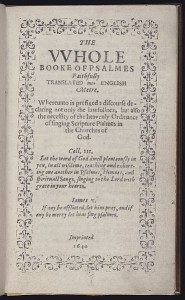Ravenscroft, Psalm 98 (Bay Psalm Book)
With Thanksgiving approaching, lets take a look at the music of early American settlers.
First, a disclaimer: Thomas Ravenscroft (c. 1588-1635) was British, not American. But if you plopped down in a group of Pilgrims in Massachusetts in 1640, you might have a hard time deciding what things should be called American rather than British. Ravenscroft did not venture to the New World, so we can safely classify him as British.
Music from Britain traveled to Plymouth Rock, however. It came without many of the resources that would have been available in England – music schools offering extensive training, pipe organs, patronage, to name a few. But settlers bring music with them, and music would have played an important part in their social and cultural life, a link to their roots and a means of expressing the enormous challenges of moving to a new continent. And, of course, it was the at the core of what defined and motivated them – their Puritan religion.

The first book published in the American colonies was the Bay Psalm Book in 1640. This metrical Psalter contained the words but not the tunes. The Puritans knew the tunes well. A metrical Psalter would categorize the texts according to meter and allow the singers to pair the text with various tunes that had a matching meter. And while the Bay Psalm Book was the first to be published in America, the Pilgrims brought several Psalters over from England, including the Ravenscroft’s Whole Booke of Psalmes (1621). Ravenscroft included many of the Psalm tunes in 4-voice settings. Some were by the leading composers of the time and some by Ravenscroft himself. But Ravenscroft is remembered for collecting folk songs, rounds, and catches. One of his collections includes the first appearance of “Three Blind Mice.”
You would more likely find the Puritans “lining out” a Psalm, with a leader singing a line of the melody and the congregation repeating it. It was monophonic and unaccompanied. But, as Quire Cleveland notes in the video description, the Bay Psalm Book recommends use of Ravenscroft’s psalm settings. So the video presents a rather refined version of music of the time, something the Puritans were unlikely to achieve.
If you want to dig deeper into the lining out of Psalms in Puritan times, Professor Carol explores that topic in both Exploring American’s Musical Heritage and America’s Artistic Legacy.



